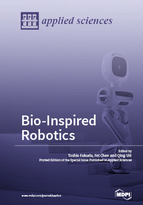Bio-Inspired Robotics
A special issue of Applied Sciences (ISSN 2076-3417). This special issue belongs to the section "Mechanical Engineering".
Deadline for manuscript submissions: closed (15 November 2017) | Viewed by 206101
Special Issue Editors
2. Department of Mechatronics Engineering, Meijo University, Nagoya, Aichi Prefecture 468-0073, Japan
3. School of Mechatronical Engineering, Beijing Institute of Technology, Beijing, 100081, China
Interests: intelligent robotic and mechatronic system; cellular robotic system; micro- and nano-robotic system
Special Issues, Collections and Topics in MDPI journals
Interests: mobile and dexterous manipulation; collaborative robotics; robot learning
Special Issues, Collections and Topics in MDPI journals
Interests: biomimetic robots; cognitive robots; robotic vision
Special Issues, Collections and Topics in MDPI journals
Special Issue Information
Dear Colleagues,
Modern robotic technologies have enabled robots to operate in a variety of unstructured and dynamically-changing environments, in addition to traditional structured environments. Robots have, thus, become an important element in our everyday lives. One key approach to develop such intelligent and autonomous robots is to draw inspiration from biological systems. Biological structure, mechanisms, and underlying principles have the potential to feed new ideas to support the improvement of conventional robotic designs and control. Such biological principles usually originate from animal or even plant models for robots, which can sense, think, walk, swim, crawl, or fly. Thus, it is believed that these bio-inspired methods are becoming increasingly important in the face of complex applications. Bio-inspired robotics is leading to the study of innovative structures and computing with sensory-motor coordination and learning to achieve intelligence, flexibility, stability, and adaptation for emergent robotic applications, such as manipulation, learning, and control.
This Special Issue invites original papers of innovative ideas and concepts, new discoveries and improvements, and novel applications and business models relevant to the selected topics of "Bio-Inspired Robotics".
Professor Toshio Fukuda
Dr. Fei Chen
Dr. Qing Shi
Guest Editors
Manuscript Submission Information
Manuscripts should be submitted online at www.mdpi.com by registering and logging in to this website. Once you are registered, click here to go to the submission form. Manuscripts can be submitted until the deadline. All submissions that pass pre-check are peer-reviewed. Accepted papers will be published continuously in the journal (as soon as accepted) and will be listed together on the special issue website. Research articles, review articles as well as short communications are invited. For planned papers, a title and short abstract (about 100 words) can be sent to the Editorial Office for announcement on this website.
Submitted manuscripts should not have been published previously, nor be under consideration for publication elsewhere (except conference proceedings papers). All manuscripts are thoroughly refereed through a single-blind peer-review process. A guide for authors and other relevant information for submission of manuscripts is available on the Instructions for Authors page. Applied Sciences is an international peer-reviewed open access semimonthly journal published by MDPI.
Please visit the Instructions for Authors page before submitting a manuscript. The Article Processing Charge (APC) for publication in this open access journal is 2400 CHF (Swiss Francs). Submitted papers should be well formatted and use good English. Authors may use MDPI's English editing service prior to publication or during author revisions.
Keywords
Bio-inspired manipulation
Bio-inspired learning and control
Bio-inspired sensory-motor coordination
Bio-inspired robot design and application
Bio-inspired computation for robots
Biomimetic robots
Bio-inspired robotic locomotion
Cyber-physical bio-system







